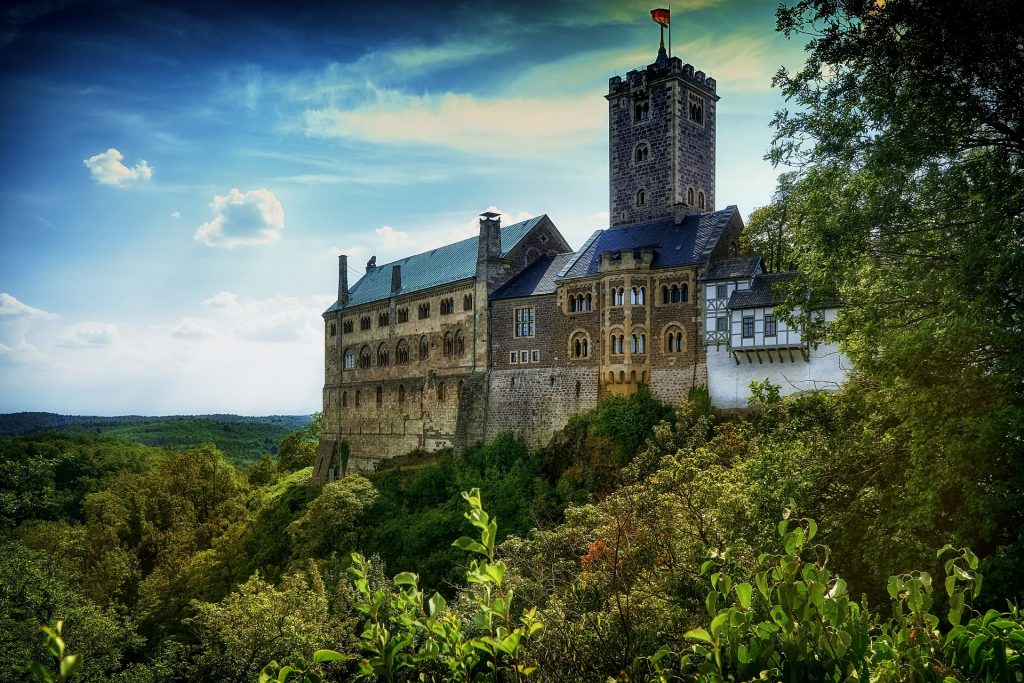transports its guests into the world of historical trade and time-honoured, almost forgotten crafts.
Candle makers, glass blowers, dressmakers, lantern makers, soap makers, stonemasons, herb women, tin casters and traveling traders offer their wares for sale on the Advent weekends. Musicians provide entertainment and joy. All in the unique setting of the famous Wartburg Castle, which has been a UNESCO World Heritage Site since 1999.

The Wartburg was built in the Middle Ages. It overlooks the town of Eisenach, in the state of Thuringia, Germany.
The castle still contains substantial original structures from the 12th through 15th centuries. Although extensive restorations of the interior took place in the 19th century. Wartburg Castle was inscribed on the UNESCO World Heritage List, because of its quintessential medieval architecture and its historical and religious significance.
The castle’s foundation was laid about 1067 by the Thuringian count of Schauenburg, Louis the Springer.
The castle was first mentioned in a written document by Bruno, Bishop of Merseburg, in his De Bello Saxonico (“The Saxon War”) as Wartberg in 1080.
From 1172 to 1211, the Wartburg was one of the most important princes’ courts in the German empire. Hermann I supported poets like Walther von der Vogelweide and Wolfram von Eschenbach, who wrote part of his Parzival here in 1203.
The castle thus became the setting for the legendary Sängerkrieg, or “Minstrels’ War“. In this contest such Minstrels as Walther von der Vogelweide, Wolfram von Eschenbach, Albrecht von Halberstadt (the translator of Ovid) and many others supposedly took part in 1206/1207. The legend of this event was later used by Richard Wagner in his opera Tannhäuser.
At the age of four, St. Elisabeth of Hungary was sent by her mother to the Wartburg to be raised to become consort of Landgrave Ludwig IV of Thuringia. From 1211 to 1228, she lived in the castle and was renowned for her charitable work. She was canonized as a saint of the Roman Catholic Church just five years after her death.
In 1320, substantial reconstruction work was done. The castle had been damaged in a fire caused by lightning in 1317 or 1318. A chapel was added to the Palas.
The Wartburg remained the seat of the Thuringian landgraves until 1440.
From May 1521 to March 1522, Martin Luther stayed at the castle under the name of Junker Jörg (the Squire George). He had been taken there for his own safety at the request of Frederick the Wise. This was because of his excommunication by Pope Leo X and his refusal to recant at the Diet of Worms. It was during this period that Luther translated the New Testament from ancient Greek into German.
Over the next centuries, the castle fell increasingly into disuse and disrepair. Especially so after the end of the Thirty Years’ War, when it had served as a refuge for the ruling family.
In 1777, Johann Wolfgang von Goethe stayed at the Wartburg for five weeks, making various drawings of the buildings.
Under communist rule during the time of the GDR extensive reconstruction took place in 1952-54. In particular, much of the Palas was restored to its original Romanesque style.